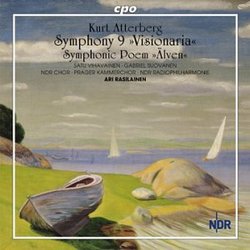| All Artists: Gabriel Suovanen, Kurt Atterberg, Ari Rasilainen, Satu Vihavainen, NDR Orchestra, NDR Philharmonic Orchestra (Hannover) Title: Kurt Atterberg: Symphony No. 9 "Visionaria"; Symphonic Poem "Älven" Members Wishing: 0 Total Copies: 0 Label: Cpo Records Release Date: 7/15/2003 Genre: Classical Style: Symphonies Number of Discs: 1 SwapaCD Credits: 1 UPC: 761203991327 |
Search - Gabriel Suovanen, Kurt Atterberg, Ari Rasilainen :: Kurt Atterberg: Symphony No. 9 "Visionaria"; Symphonic Poem "Älven"
 | Gabriel Suovanen, Kurt Atterberg, Ari Rasilainen Kurt Atterberg: Symphony No. 9 "Visionaria"; Symphonic Poem "Älven" Genre: Classical |
Larger Image |
CD DetailsSimilar CDs
|
CD ReviewsThe Symphony of Power, Vision, Reality - The Poem of Beauty David A. Hollingsworth | Washington, DC USA | 08/21/2003 (5 out of 5 stars) "Kurt Atterberg's Ninth Symphony "Sinfornia Visionaria" (1955-1956) have a pretty curious performance history. After its premiere in Helsinki in 1957, the work was shelved until another performance, which commenced in 1962. Thirteen years passed for yet another performance of the work to take place (on an anniversary of the composer's demise). As Michael Kube explains in his authoritative essay, the work creates the impression of a reflection of the political climate during the 1950s (the Cold War being the primary source of fear as well as political and social instabilities for much of the global community). The selection of the text derives from the Old Norse apocalyptic poem entitled "Voluspa" (otherwise called "The Face of the Prophetess"). While not a clear cut as, say, Dvorak's Requiem, as far as structure is concerned, the piece can be divided into two parts. The first part (tracks 1-4) deals with the genesis of Midgard (the Earth- as told by Heid), the world which at first had no sea, no arching earth, no heaven above, no sand (when Ymir was alive). But, when the Sons of Bur emerged, the land was lifted, the sun shone, and plants and herbs grew. The universe expanded and yet everything remains peaceful, until the first human murder (track five - which begins the second part). Battles ensued and Odin, presumably in pursuit of those who killed Gullveig, died in one of those battles. Mankind left Midgard as the sun blackens and the land sank into the sea.Immediately one may think of Wagner's "Der Ring des Nibelungen" in the message that it brings (namely that greed will destroy the human race). Atterberg's piece is not as hedonistic as Orff's Carmina Burana; although the first part of the former is as celebratory of Mother Earth as the Primo Vere section in Orff's, but with greater arresting subtlety. But I wonder whether the composer was familiar with Dvorak's masterpiece. For example, Atterberg's text (in track eight) "Garm howls dangerously at Gnupa's cave. Shattering the chains, the wolf frees himself. Coiling serpent wants to swallow the world, it spews forth venom and fire's heat" have striking similarities with the Dies Irae movement of Dvorak's Requiem, not only in the wording, but also in the handling of the material: the feeling of damnation that's poignant. His use of a twelve-tone row when the text speaks of Evil affecting the world is especially compelling. Notwithstanding these references, the piece is wholly striking in its own terms. As usual with Sweden's most gifted melodist, the orchestration is as masterly as expected; it is vivid yet more menancing as the piece goes along. I cannot even ignore the gripping subtlety of the first part: its very picturesque in the coming of Earth-but with a feeling of detachment and prophesy that has anticipation of what's coming (and the contemplative ending holds the prophesy true as that subtlety returns). But the text and his handling of it shows ingenuity and boldness given the date of the composition (and even for the global political climate that remained unstable and violent as we speak, the work is quite more appropriate). I confess, I was expecting the Symphony to be about an hour long (at forty minutes, the Symphony can sound perfunctory especially since the Earth did not end because of the will of mankind to initiate peace and good will, usually due to the minority who saw the world at a different angle and convince the greater minority-majority to do the same). The Symphonic Poem "Alven-The River" is quite an effective score. Written in 1929, it conveys Atterberg's love for Sweden, which by itself evokes Smetana's "Ma Vlast." Even the grandiose beginning brings to mind Smetana's masterpiece ('Vltava' to be exact), yet the ensuing development suggest the composer's familiarity with Hugo Alfven's Fourth Symphony "Fran Havsbandet" (of 1919-which created quite a stir after its premiere that same year). Atterberg's tone poem is as skillfully written and the 'The Great Lake' movement in particular holds magic and wonder (as does the 'Waterfall'). I was actually amused when I was listening to 'The harbour'- it has this Nielsenian pictoresque humor to it. So, while Smetana's masterpiece can be evoked at various points, Atterberg's poem holds up well on its own. Ari Rasilainen's pioneering venture in Atterberg's music deserves every bit of everlasting praise and respect. And the CPO enterprising project continues to reveal what we're missing. Not only is Rasilainen's account fresh, but it is with authority and a real understanding of the composer's works. I cannot find a single fault in his revelatory performance of the "Sinfornia Visionaria." It's narrative in character and Rasilainen's shaping and approach shows powerful yet moving restraints and hair-raising menace throughout. His views of "Alven" likewise shows vision and the NDR Radio Philharmonic (as with the NDR Choir and the Prague Chamber Choir in the Symphony) respond with full artistry and verve. The same shall be said of soloists Satu Vihavainen & Gabriel Suovanen, who sang with such narrative relishment. At sixty minutes, one can only wish for at least another work or two to fill up this well recorded, realistically sounding compact disc. But, it remains visionary quite literally and quite imaginatively so, and for that I shall remain eternally grateful." Out of the Flinty North Thomas F. Bertonneau | Oswego, NY United States | 02/15/2004 (4 out of 5 stars) "Kurt Atterberg (1887 - 1974) belongs to the school of what Nicolas Slonimsky calls (in Baker's Biographical Dictionary of Composers and Musicians) "Swedish Hyper-Romanticism." Slightly younger than the ground-breaking national romantic composers Hugo Alfvén (1872 - 1962) and Vilhelm Peterson-Berger (1867 - 1942), Atterberg followed the lead of those elder artists by incorporating the modal outlines of Swedish folksong - and its implied harmonies - into his concert music. The descriptive titles of many of Atterberg's works tell the story: "West Coast Pictures" (Symphony No. 3), "A Värmland Rhapsody," and "Ballade and Passacaglia." Like Alfvén, Atterberg felt the allure of the Stockholm Archipelago - but, as a Gothenburger, he also responded to the natural beauty of Sweden's western littoral. (Sweden has a west coast! - it is not exclusively a Baltic nation.) towards the end of his compositional career, in the aftermath of World War Two, Atterberg returned to the sources of Scandinavian culture, the prophetic verses of the Elder Edda, to write his choral-orchestral Ninth Symphony, the "Sinfonia Visionaria" (1953). The idea of setting an apocalyptic text in an oratorio-symphony had already occurred to one Swedish composer, Hilding Rosenberg, whose "Revelation of Saint John" (1944), also listed as his Symphony No. 4, struck many a nerve in its time. Rosenberg's "Revelation," which has had two or three recordings, is full of blaring trumpets in the Hindemith manner and bold expostulations from the chorus - a real aural spectacle. Atterberg had in mind to do it differently from Rosenberg: "Sinfonia Visionaria" avoids the near-hysteria of the other artist's mode in favor of a quieter, rather more mystical contemplation of man's inhumanity to man in an age of world wars and atomic weapons. The Symphony plays continuously, mainly in moderate and slow tempi, but corresponds to a number of distinct sections. The CPO disc tracks these sections separately. The Edda-verses in question - sometimes called "The Sybil's Prophecy" - tell of the destruction of the world in a paroxysm of deadly winter ("Fimbulvinter"), the unleashing of monsters against gods and men ("World-Serpent" and "Fenris-Wolf") , and a final tempest of fire and smoke ("Ragnarök"). Richard Wagner drew on these same visions in "Die Gotterdämmerung," the fourth installment of his "Ring." The medieval-music ensemble Sequentia also covers some of this material in their CD entitled "Edda." If the result, in Atterberg's work, were more cantata than symphony, the main sections of a four-part symphonic composition are nevertheless discernible. "Sinfonia Visionaria" does not reveal its art entirely on a first listening, but this is a sign of its subtle character: re-visitation discloses the score's felicities. The symphonic poem "Älven" (Swedish for "The River") is a more outgoing composition than the symphony, a Swedish variant of Smetana's "Moldau" or Schumann's "Rhenish" Symphony. "The River" generates a good deal of fun and nicely balances the austerity of the cantata-symphony. Ari Rasilainen plays these two scores, as he has played his way through his entire Atterberg cycle for CPO, with commitment and élan. Recommended. And not only for aficionados of Scandinavian symphonism." Symphonic poem is good P. Weber | Los Angeles | 04/28/2010 (3 out of 5 stars) "Didn't like symphony 9 at all, dreary and uninspired. The rest of Atterberg's symphonies are far more appealling than this one. But the symphonic poem Alven is very nice. Get this CD for the poem."
|



